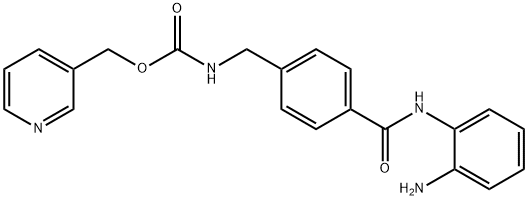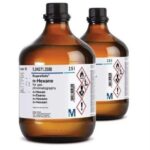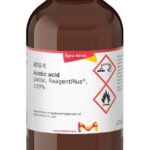| Description | Entinostat (SNDX-275, MS-275) belongs to benzamide class HDACi and inhibits HDAC1 and 2, 3 and 9 and has low effect against HDAC4, 6, 7 and 8 (Khan et al. 2007). Entinostat is in phase II clinical trial for treatment of Hodgkin’s lymphoma and advanced breast cancer (in combination with aromatase inhibitors) and metastatic lung cancer (in combination with erlotinib). |
| Chemical Properties | Yellow Solid |
| Uses | Entinostat is an emerging HDACi (histone deacetylase inhibitor). Entinostat is used for treatment of solid tumors and hematologic malignancies. |
| Uses | Entinostat is an emerging HDACi (histone deacetylase inhibitor). Entinostat is used for treatment of solid tumors and hematologic malignancies. Potent Histone deacetylase inhibitor. |
| Definition | ChEBI: A member of the class of benzamides resulting from the formal condensation of the carboxy group of the pyridin-3-ylmethyl carbamate derivative of p-(aminomethyl)benzoic acid with one of the amino groups of benzene-1,2-diamine. It is an inhibit r of histone deacetylase isoform 1 (HDAC1) and isoform 3 (HDAC3). |
| Clinical Use | Entinostat is an HDAC inhibitor with a relatively long half-life (averaging between 33 and 52 hours). Trials have shown significant biological activity in patients with hematological malignancies receiving entinostat treatments. However, the efficacy of entinostat as a single-agent therapy remains limited. Reported dose-limiting toxicities associated with entinostat include neurotoxicity, fatigue, hypophosphatemia, anorexia, and vomiting.
The large number of clinical trials using HDAC inhibitors for the treatment of patients with hematological malignancies has demonstrated that these drugs are relatively well tolerated. Although the responses with the currently-available HDAC inhibitors are still limited, there are significant responses in some patients with advanced disease, where options are limited. With better patient selection and the development of more potent HDAC inhibitors, targeting HDACs for the treatment of hematological malignancies remains promising. Furthermore, a growing body of literature suggests that HDAC inhibitors may potentiate some of the currently used cytotoxic or biologic therapies based on their mechanism of action, with multiple trials currently ongoing. Promising combination partners include proteosome inhibitors, DNA demethylating agents, and anthracyclines. |
| target | HDAC1 |
| References | 1) Hu et al. (2003), Identification of novel isoform-selective inhibitors within class 1 histone deacetylases; J. Pharmacol. Exp. Ther., 307 720 2) Saito et al. (1999), A synthetic inhibitor of histone deacetylase, MS-275, with marked in vivo antitumor activity against human tumors; Proc. Natl. Acad. Sci. USA, 96 4592 3) Eyupoglu et al. (2006), Experimental therapy of malignant gliomas using the inhibitor of histone deacetylase MS-275; Mol. Cancer Ther., 5 1248 4) Lee et al. (2001), MS-275, a histone deacetylase inhibitor, selectively induces transforming growth factor beta type II receptor expression in human breast cancer cells; J. Pharmacol. Exp. Ther., 307 720 5) Lin et al. (2007), Anti-rheumatic activities of histone deacetylase (HDAC) inhibitors in vivo in collagen-induced arthritis in rodents; Br. J. Pharmacol., 150 862 6) Fukuchi et al. (2015), Class I histone deacetylase-mediated repression of the proximal promoter of the Activity-regulated Cytoskeleton-associated Protein Gene regulates its response to brain-derived neurotrophic factor; J. Biol. Chem. 290 6825 [Focus Biomolecules Citation] |









